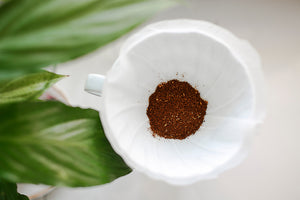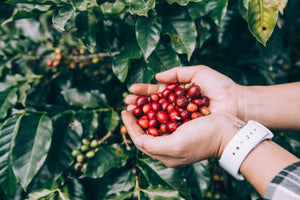
A History of London Coffee - Part 3 of 5
Main photo - Pavilion Cafe which opened in 2008, a longstanding Square Mile customer.
2007 – A WBC win and the birth of Square Mile
You may remember part one of our history of London coffee which set up the backstory before 2000. Part two took us up to the end of 2006. Now are you sitting comfortable for part three?
In January 2007 Jorge Fernandez who had worked alongside Gwilym Davies at Monmouth set up not a new Soho café with Rick Wells – Fernandez and Wells serving food and wine on Lexington Street where they discovered they couldn’t fit an espresso machine. So they opened in Beak Street in March of that year serving coffee too, initially from Monmouth. They now have grown to six spaces across London.
The single most important events in the development of the London scene arguably happened in 2007 and they involved James Hoffmann and Anette Moldvaer. James for La Spaziale, distributing espresso machines and training baristas. Before that he had sold Gaggia machines in a department store. Anette though less known played a pivotal role. She had been a barista in Norway, a country that had evolved a lightly roasted speciality scene in Oslo which would prove influential on the London scene. In the UK she worked at the London School of Coffee. There Anette met James. She trained and encouraged him and Anette helped James win the UK Barista Championships and the World Barista Championship that year, using a coffee both Anette roasted for him. She herself won the world cupping championship in May 2007. James winning the WBC turned the spotlight on UK coffee and provided a spark for the nascent scene.
James and Anette formed Square Mile Roasters in 2008 and have consistently sought out excellence ever since, both in seeking out excellent beans, in employing the best people, in helping develop coffee knowledge, and in developing roasting profiles that bring out the best flavour in coffees. Most of all, Square Mile brought a Scandinavian influence to the London scene which led to a style of coffee distinct from Australia, New Zealand and America, establishing medium-light roast coffees on the London scene.
Square Mile gradually dominated the London scene over the next two or so years.
Whereas in 2007 and even 2008, most progressive cafes served Monmouth coffee, after that time Square Mile was everywhere and when they switched from Spring to Summer espresso, you knew you’d be drinking that most of the time for the next few months. It was all espresso too; good filter coffee was much rarer to find. Square Mile surged to success but community aspect was equally important. As James says , ‘The company was created to not only source and roast coffees that would get people excited and interested in coffee, but it was also created to help foster a culture and community of coffee in London’. This led to a spirit of co-operation and fun and Square Mile hosted regular party style events such as the Ultimate Barista Fighter.
As Rob Dunne put it, when talking to us in 2012 of his recollections of the London scene back then, “From my external observations it was predominately the movements of a tiny core group of people looking for more variety of coffee and higher quality within the London scene. Monmouth had been paving the way for many years, laying a solid foundation for others to stand on and improve upon. It was the introduction of Square Mile which initially offered the only alternative for Independents thus acting as the catalyst which produced today’s ever expanding cafe scene within London. Square Mile introduced a higher standard, with a cultural mix up of English / Scandinavian coffee knowledge.”
Pitch 42 and the Colombia Road stall were more fully established in 2007. Tim Styles was at Climpson and Sons, Flat White was buzzing and Jack Coleman was making great coffees at Fernandez and Wells. The scene was set.
2008 It builds
Nude Espresso opened in 2008, initially roasting below their cafe off Brick Lane but a year later opening their own roaster down the road. The owners were experienced in the New Zealand, Australian and Canadian coffee markets. The café had a host of loyal regulars initially roasting slightly on the darker side reflecting antipodean preference.
In April 2008 Taste of Bitter Love opened on Hackney Road, it was beloved of many; Hackney was very much the centre of the scene...with a few decent places in Soho and of course Monmouth in Covent Garden. Taste of Bitter Love had a friendly feel, great cakes and food and emphasised delicious coffee. It had a quirky, arty style that fit the local scene but it was never pretentious, always welcoming
Shelagh Ryan brought a touch of Oz to Fitzrovia in 2008 with Lantana – much, much imitated over the years. She brought casual, good quality all day dining to London and the coffee was always important to her. It’s been so successful in later years she has bought up the next door cafe purely for take-outs and opened other branches in Shoreditch and Camden.
Stephen Morrissey won the WBC in 2008 representing Ireland, he worked for Square Mile and Anette again roasted the winning coffee. The win established London as a core for a small growing coffee community in a way events had previously in Oslo. Stephen influenced many in the London scene before moving to the US, founding Coffee Common and working for Intelligentsia and the SCAA. At the time of his win, he acknowledged support from James and Anette but also Tim Styles Williams and Bea Vo.
Another important cafe, Dose Espresso opened in December 2008. Their tiny cafe opposite Smithfield Market (next door to their current larger premises) was a rare spot for great coffee outside the East End and the West End. Owner/barista James Phillips had worked as a barista in Sydney. Dose emphasised charities such as Coffee Kids and were one of the first to use fully compostable cups. In Paris, Robert Robinson had been running a coffee stall and Fabio Ferreira joined him in 2008 to run the Flat Cap stall in Strutton Ground near Victoria. The stall developed a great reputation over the years and was the beginning of Notes Coffee shops.
Meanwhile, out West, Electric Coffee took over a business called Café Freddo but served coffee from Union Hand Roasters, served flat whites and went on change their name and to become a site that showed potential as far out as Ealing Broadway. The scene was expanding, Taylor St Baristas opened their second café this year in New Street opposite Liverpool Street Station, a brave move with the great insight of opening in the City and a location that served as a starting point for many who made great waves in the future. It was a hint of future possibilities, as was the opening of London’s first Cycle Café, Lock 7 that same year.
As we mentioned in the last instalment, Flat White had introduced Londoners to Aussie and Kiwi style in 2005 and by 2008, they’d developed Soho as enough of a coffee outpost to open a second branch Milk Bar (a term for a corner shop in Australia). That same year, Rob Green opened Pavilion with Brett Redman, after Brett previously ran a small cafe called Elliot’s in Bethnal Green (where Rob was a regular customer). Set in fabulous Victoria Park, Rob and Brett soon earned a great reputation for their food – especially brunch – but coffee was always a big deal – and Pavilion have always served Square Mile coffee. Brett and Rob have now gone their separate ways and Rob runs Pavilion Café and Pavilion Bakery
The stage was set for the expansion of the London coffee scene in 2009 including the openings of such favourites as Kaffeine, The Espresso Room, Look Mum No Hands and Tina We Salute You. All that and another British World Barista Champion!
by Phil Wain - Former Editor



